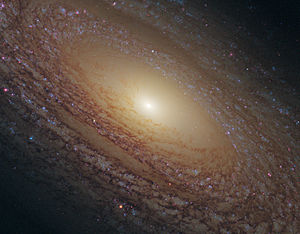NGC 2841
| Galaxy NGC 2841 |
|
|---|---|

|
|
| Photo from the Hubble Space Telescope | |
| AladinLite | |
| Constellation | Big Bear |
|
Position equinox : J2000.0 , epoch : J2000.0 |
|
| Right ascension | 09 h 22 m 02.6 s |
| declination | + 50 ° 58 ′ 35 ″ |
| Appearance | |
| Morphological type | SA (r) b: / LINER / Sy1 |
| Brightness (visual) | 9.3 mag |
| Brightness (B-band) | 10.1 mag |
| Angular expansion | 8.1 ′ × 3.5 ′ |
| Position angle | 147 ° |
| Surface brightness | 12.8 mag / arcmin² |
| Physical data | |
| Affiliation | NGC-2841 group |
| Redshift | 0.002128 ± 0.000010 |
| Radial velocity | (638 ± 3) km / s |
|
Stroke distance v rad / H 0 |
(30 ± 2) x 10 6 ly (9.23 ± 0.65) Mpc |
| history | |
| discovery | Wilhelm Herschel |
| Discovery date | March 9, 1788 |
| Catalog names | |
| NGC 2841 • UGC 4966 • PGC 26512 • CGCG 265-006 • MCG + 09-16-005 • IRAS 09185 + 5111 • 2MASX J09220265 + 5058353 • GC 1823 • H I 205 • h 584 • Kara 324 • KIG 324 | |
NGC 2841 is a spiral galaxy with an active nucleus of the Hubble type Sb in the constellation Great Bear in the northern sky . It is estimated to be 30 million light years away from the Milky Way and about 70,000 light years in diameter.
Together with NGC 2500 , NGC 2537 , NGC 2541 , NGC 2552 and NGC 2681 , it forms the NGC 2841 galaxy group .
In this galaxy the supernovae SN 1912A , SN 1957A ( Type-Ia / P), SN 1972R (Type-Ib) and SN 1999by (Type-Ia / P) were observed.
The object was discovered on March 9, 1788 by the German-British astronomer Wilhelm Herschel .
literature
- Zhang et al. (2018): The Dragonfly Nearby Galaxies Survey. IV. A Giant Stellar Disk in NGC 2841. In: The Astrophysical Journal. 855 (2).
Web links
Commons : NGC 2841 - album containing pictures, videos and audio files
- SIMBAD Astronomical Database
- GoBlack
- Supernova 1999by in Spiral Galaxy NGC 2841
- Spektrum.de : Amateur recordings [1] [2] [3] [4]
